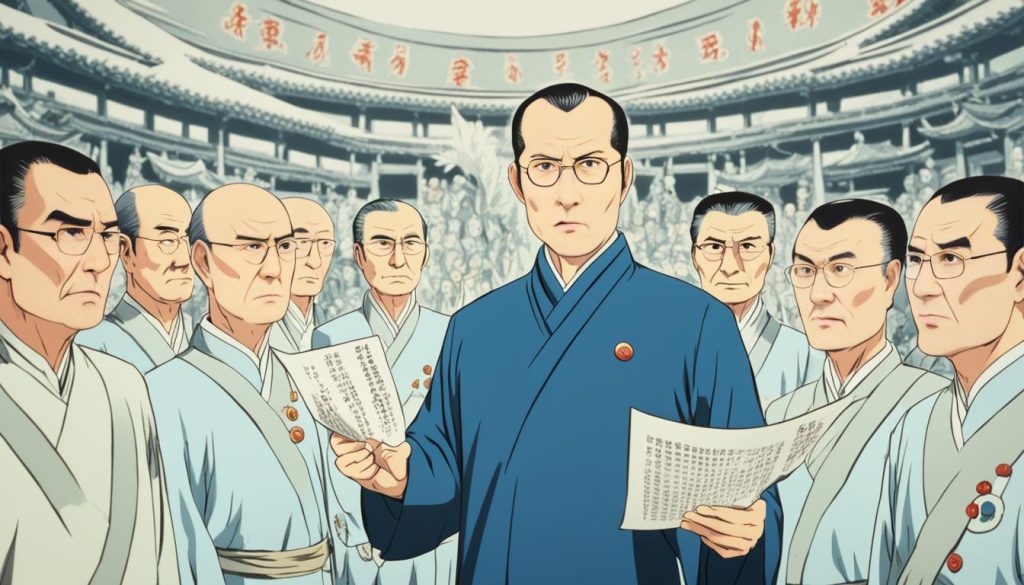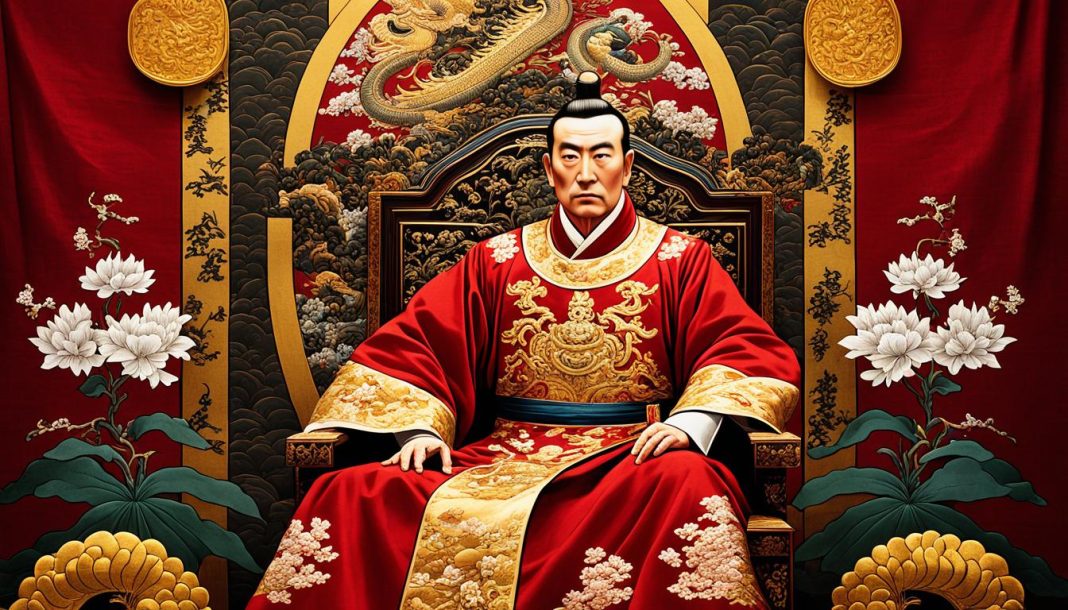Emperor Guangxu, also known as Guangxu Emperor, was a reform-minded Chinese emperor who ruled during the late Qing Dynasty in Imperial China. His reign was marked by his vision for modernizing the country, but his efforts faced strong opposition from conservative forces, led by Empress Dowager Cixi. Despite the challenges, Guangxu’s progressive ideas and desire to bring about political, economic, and social reforms have left a lasting impact on Chinese history.
Key Takeaways:
- Emperor Guangxu was a reform-minded leader during the late Qing Dynasty in China.
- His efforts to modernize China were hindered by Empress Dowager Cixi and conservative forces.
- Guangxu’s reign ended with the Xinhai Revolution, which overthrew the Qing Dynasty and established a republic.
- His cultural and intellectual contributions, as well as his attempts at reform, continue to be recognized and studied today.
- Emperor Guangxu’s legacy serves as a reminder of the challenges faced by visionary leaders in the face of entrenched conservatism.
Early Life and Ascension to the Throne
Emperor Guangxu, originally named Zaitian, was born in 1871. At the age of four, he ascended to the throne of the Qing Dynasty in 1875. However, his reign did not begin with full autonomy, as Empress Dowager Cixi, a significant figure in the imperial court, held considerable power and influence. Despite this, Emperor Guangxu’s intelligence and his desire to bring about positive change in China were evident from an early age.
Emperor Guangxu received a modern education that exposed him to Western ideas and ideologies, which would greatly influence his reign. His exposure to these progressive ideas sparked his ambition to transform China and modernize its institutions. Emperor Guangxu’s early life and ascension to the throne set the stage for his later efforts to implement widespread reforms.
“I am dedicated to the well-being and prosperity of our nation. I shall work tirelessly to usher in a new era of progress and enlightenment for the Chinese people.”
Guangxu’s Reforms and Modernization Efforts
Emperor Guangxu of the Qing Dynasty was a visionary Chinese emperor who recognized the need for reform and modernization in Imperial China. During his reign, he implemented a series of significant reforms with the aim of modernizing the Chinese government, military, education system, and economy.
To achieve his goals, Guangxu introduced Western-style schools to provide a modern education for Chinese citizens. He recognized the importance of industrialization and actively promoted the adoption of modern technologies in various sectors of the economy. These efforts aimed to position China as a competitive player on the global stage and close the technological gap.
Recognizing the need for political reform, Emperor Guangxu established an advisory council to provide guidance and support for the government. He also implemented new constitutional reforms, aiming to establish a more accountable and representative political system.
“It is essential for China to embrace change and adapt to the demands of the modern world. Only through reform and modernization can we secure our place among the leading nations,”
– Emperor Guangxu
However, Guangxu’s reforms faced significant opposition from conservative forces within the imperial court, including Empress Dowager Cixi. They feared that these reforms threatened their own power and resisted the changes brought forth by Guangxu.
Empress Dowager Cixi’s Influence and Opposition
Empress Dowager Cixi, as the de facto ruler of China, held significant power and influence over Emperor Guangxu. She opposed many of his reform efforts and saw them as a threat to her own power. Cixi, known for her conservative approach and resistance to change, took control of the government and undermined Guangxu’s authority. She reversed or blocked his reforms, leading to a power struggle and tension within the imperial court.
“Cixi’s opposition to Guangxu’s initiatives demonstrates the clash between progressive change and entrenched conservative forces during the late Qing Dynasty.”
Despite Emperor Guangxu’s vision for modernization, his reform efforts were met with strong opposition from Empress Dowager Cixi and other conservative forces. Cixi’s resistance to change hindered Guangxu’s ability to implement his reforms fully, leading to a contentious and challenging period in the late Qing Dynasty. Guangxu’s progressive ideals faced significant barriers as he sought to transform Imperial China.
The Power Struggle
The tension between Emperor Guangxu and Empress Dowager Cixi in the imperial court increased as Guangxu pushed for change. Cixi’s influence over the government allowed her to manipulate and control the direction of policies, often hindering the reform-minded Guangxu. This power struggle between Guangxu’s vision and Cixi’s conservative agenda created a dynamic that shaped the late Qing Dynasty’s history.
Cixi’s opposition to Guangxu’s reform initiatives ultimately contributed to the failure of many of his modernization efforts. Despite his best intentions, Guangxu faced significant resistance from conservative forces that sought to uphold traditional structures of governance and resist external influences.
The Hundred Days’ Reform
The Hundred Days’ Reform, initiated by Emperor Guangxu in 1898, was a pivotal period in the Qing Dynasty’s history. Guangxu launched a comprehensive set of reforms with the goal of modernizing China and propelling it into the future.
During the Hundred Days’ Reform, Emperor Guangxu introduced significant changes that aimed to transform the political, educational, and administrative systems of Imperial China. One of the key reforms was the establishment of a constitutional monarchy, which would grant citizens greater rights and freedoms.
Guangxu also implemented a Western-style education system, recognizing the importance of modern knowledge and its application in promoting China’s development. Additionally, he sought to reform the civil service examination system, aiming to create a more merit-based bureaucracy that would encourage capable individuals to contribute to the governance of the country.
“The Hundred Days’ Reform was a bold and ambitious attempt by Emperor Guangxu to bring about much-needed modernization to China,” says Professor Li Yan, a historian at Beijing University. “He recognized that embracing reform was crucial to uplifting the nation and keeping pace with other global powers.”
However, the reform efforts faced staunch opposition from conservative factions, including Empress Dowager Cixi. She was against many of Guangxu’s progressive ideas and feared that they would undermine her own authority. The opposition eventually led to the reversal of the reforms, and Emperor Guangxu was placed under house arrest for the remainder of his reign.

The Hundred Days’ Reform, though short-lived, left a lasting impact on China’s trajectory towards modernization. It brought the importance of reform and change to the forefront of national discourse, laying the foundation for future reform movements and contributing to the eventual downfall of the Qing Dynasty.
“The Hundred Days’ Reform served as a catalyst for the subsequent waves of reform and revolution in China,” says Professor Li Yan. “It planted the seeds of change that would later bear fruit during the Xinhai Revolution, leading to the end of imperial rule in China.”
Guangxu’s Cultural and Intellectual Contributions
Emperor Guangxu, a prominent figure in the late Qing Dynasty, left a profound impact on Chinese culture and intellectual development during his reign. As a patron of the arts, Guangxu actively supported the growth and refinement of literature, calligraphy, and painting. His appreciation for these artistic forms nurtured a flourishing cultural scene that continues to influence Chinese aesthetics to this day.
Furthermore, Guangxu recognized the significance of Western sciences and technologies and endeavored to incorporate them into Chinese society. His enlightened mindset led to the fostering of intellectual growth and the expansion of knowledge within the country. By encouraging intellectuals and scholars to explore new ideas, Guangxu laid the foundation for future cultural and intellectual advancements in China.
The Xinhai Revolution and the End of the Qing Dynasty
The Xinhai Revolution, also known as the 1911 Revolution, marked the end of the Qing Dynasty and the establishment of the Republic of China. This revolution was a response to the widespread discontent with the Qing government, including the limited power of Emperor Guangxu and the influence of Empress Dowager Cixi. Supported by a coalition of revolutionaries, military leaders, and intellectuals, the Xinhai Revolution sought to bring about fundamental change in China.

Image:
As the Qing Dynasty faced mounting pressure, a series of uprisings erupted across the country. These uprisings were fueled by a desire for political reform, modernization, and the overthrow of the imperial system. The Xinhai Revolution gained momentum, leading to the abdication of Emperor Guangxu in 1912.
The revolution’s success marked a turning point in Chinese history, as it brought an end to more than two millennia of imperial rule. The establishment of the Republic of China represented a shift towards a more democratic and modern society.
However, the Xinhai Revolution did not immediately resolve all of China’s problems. The country still faced numerous challenges, including regional fragmentation, political instability, and foreign interference. Nevertheless, the revolution laid the groundwork for future developments and set the stage for the transformation of China into a modern nation.
Legacy and Historical Significance of Emperor Guangxu
Emperor Guangxu’s reign and his reform efforts have had a lasting impact on Chinese history. His vision for modernizing China laid the groundwork for future reforms and developments in different areas of society. Guangxu’s efforts to introduce Western ideas and technologies influenced the subsequent generations of Chinese leaders and intellectuals. Despite the obstruction he faced, his progressive ideals remain relevant in discussions of China’s transformation and modernization.
Emperor Guangxu’s reign during the late Qing Dynasty was a pivotal period in Chinese history. His commitment to reform and modernization reflected his understanding of the need to adapt to the changing times. By embracing Western ideas and technologies, Guangxu sought to strengthen China’s position in the world and improve the lives of its people.
The Emperor’s bold reforms covered a range of areas including governance, education, and industry. His initiatives included the establishment of Western-style schools, the promotion of industrialization, and the adoption of modern technologies. These efforts laid the foundation for China’s future development and modernization.
Guangxu’s reform agenda faced significant opposition from conservative forces, particularly the influential Empress Dowager Cixi. Despite the challenges and setbacks, the Emperor’s historical significance lies in his unwavering commitment to a new and modern China. He sought to break free from the constraints of the Qing Dynasty’s traditions and embrace progress and change.
- “The historical significance of Emperor Guangxu lies in his transformative vision for China. His efforts to promote reform and modernization paved the way for future generations to build a stronger, more prosperous nation.”
Emperor Guangxu’s legacy extends beyond his reign. His progressive ideals continue to inspire discussions on China’s path to transformation and modernization. The lessons learned from his struggles and the obstacles he faced have shaped the way we understand China’s history and the challenges faced by visionary leaders.
Today, Guangxu’s cultural and intellectual contributions during his reign are recognized and celebrated. His patronage of the arts, support for literature, calligraphy, and painting, and promotion of Western sciences and technologies have left an indelible mark on Chinese culture and intellectual development.
In conclusion, Emperor Guangxu’s reign and his commitment to reform have left an enduring impact on Chinese history. His vision for a modern China, his efforts to introduce Western ideas and technologies, and his cultural and intellectual contributions have shaped the course of Chinese society. Despite the challenges and obstacles he faced, his historical significance remains as a testament to the transformative power of visionary leadership.
Assessing Guangxu’s Leadership and Reforms
The leadership and reforms of Emperor Guangxu during the Qing Dynasty continue to be a subject of debate among historians and scholars. Some view Guangxu as a visionary leader who was ahead of his time, while others believe that his reforms were ineffective or misguided.
The constraints imposed by Empress Dowager Cixi and conservative forces limited Guangxu’s ability to fully implement his reforms. However, his efforts to modernize China and introduce Western ideas have undeniably contributed to the ongoing transformation of Chinese society.
Despite facing numerous challenges, Emperor Guangxu showed great determination and foresight in his leadership. He recognized the need for change in order to meet the demands of a rapidly evolving world. Guangxu’s vision for reform not only encompassed political and economic aspects but also aimed to modernize education and industry.
“Guangxu’s reforms were driven by the desire to strengthen China and bring it in line with the progress made by Western countries,”
His relentless pursuit of reform sparked hope and inspired the Chinese people to strive for a brighter future.
However, the resistance from conservative forces, particularly Empress Dowager Cixi, hindered Guangxu’s plans. Despite this, the impact of his reforms can still be seen today in various aspects of Chinese society, including education, technology, and governance.
Guangxu’s leadership and reforms were a catalyst for change during a pivotal period in Chinese history. His progressive ideas and efforts played a significant role in shaping the future of a nation on the verge of transformation. Though the full potential of his reforms may not have been realized during his lifetime, Guangxu’s contributions continue to echo in the ongoing development of China.
Guangxu’s Place in the Qing Dynasty’s History
Emperor Guangxu’s reign played a pivotal role in the decline and collapse of the Qing Dynasty. As a Chinese emperor during a time of significant change, his attempts at reform and modernization faced strong resistance from conservative forces within the imperial court. The historical significance of Guangxu lies in his representation of the tensions and struggles that characterized the Qing Dynasty during this transformative period.
Despite his progressive vision for reform, Guangxu’s efforts were undermined by entrenched conservatism. This serves as a reminder of the challenges faced by visionary leaders who seek to bring about change in a resistant environment. Guangxu’s legacy serves as a poignant symbol of these struggles and highlights the complexities of leadership during times of transition.
During his reign, Guangxu experienced the clash between traditional values and the need for progress. His place in history reflects not only his own aspirations for reform but also the broader historical forces at play in the decline of the Qing Dynasty. Guangxu’s reign serves as a turning point and a significant chapter in the historical narrative of China.
As we reflect on Guangxu’s place in the Qing Dynasty’s history, his struggles and legacy provide valuable insights into the complexities of governance and the challenges faced by leaders who dare to challenge the status quo. His historical significance as a symbol of change in the face of resistance continues to resonate, shaping our understanding of China’s past and its ongoing transformation.
Guangxu’s Cultural Influence and Rememberance
Emperor Guangxu’s reign left a profound cultural impact on China, which can be observed through the numerous artworks, literature, and historical records from that period. His patronage of the arts and support for intellectual pursuits played a significant role in shaping Chinese culture.
Emperor Guangxu’s reign witnessed a flourishing of artistic expression and creativity. Paintings, calligraphy, and other art forms thrived under his patronage. Artists were inspired by his progressive vision and incorporated innovative techniques and subjects into their works.
Furthermore, Guangxu’s reign encouraged intellectual development in China. The emperor’s support for educational reforms and the promotion of Western sciences and technologies fostered a culture of intellectual curiosity and innovation. This intellectual vibrancy contributed to advancements in various fields and laid the foundation for future intellectual discourse in China.
Guangxu’s reign continues to be studied by scholars and historians, who seek to understand the cultural dynamics and significance of the late Qing Dynasty. His reign serves as a valuable period for examining the struggles faced by reform-minded leaders and the cultural climate of the time.
With his contributions to Chinese culture, Emperor Guangxu’s remembrance is enshrined in the annals of history. The artistic and intellectual legacy he left behind serves as a reminder of the cultural richness and significance of his reign.
The image above offers a visual representation of Emperor Guangxu, symbolizing his cultural influence and remembrance. Through his patronage, support for intellectual pursuits, and encouragement of artistic expression, Guangxu’s reign played a pivotal role in shaping Chinese culture and continues to be recognized and commemorated today.
Conclusion
Emperor Guangxu’s reign during the late Qing Dynasty was marked by his progressive ideals and attempts to modernize China. Despite facing strong opposition from conservative forces, Guangxu’s vision for reform has left a lasting impact on Chinese history. His legacy serves as a reminder of the challenges faced by leaders seeking change in the face of resistance.
Emperor Guangxu made significant contributions to Chinese culture, education, and intellectual development. He supported the arts, literature, and the study of Western sciences, fostering a spirit of innovation and openness to new ideas. His efforts have paved the way for future advancements in these areas, and his influence continues to be recognized and celebrated.
The late Qing Dynasty witnessed a period of transition and struggle, with Guangxu’s reign acting as a focal point. His progressive ideas and desire for modernization laid the groundwork for future reforms, ultimately shaping China’s transformation. As we reflect on Emperor Guangxu’s reign, we acknowledge his resilience and legacy, highlighting the challenges and triumphs of a visionary leader in a time of great change and the lasting impact of his contributions to Chinese history.
























